Key takeaways:
- Video transitions bridge shots and convey emotional depth, enhancing storytelling and audience engagement.
- Smooth transitions are essential for maintaining narrative flow and emotional resonance, preventing viewer disorientation.
- Basic transition types, including cuts, fades, and dissolves, play a crucial role in storytelling by linking scenes effectively.
- Integrating sound design and color grading can significantly enhance transitions, adding depth and continuity to the narrative.
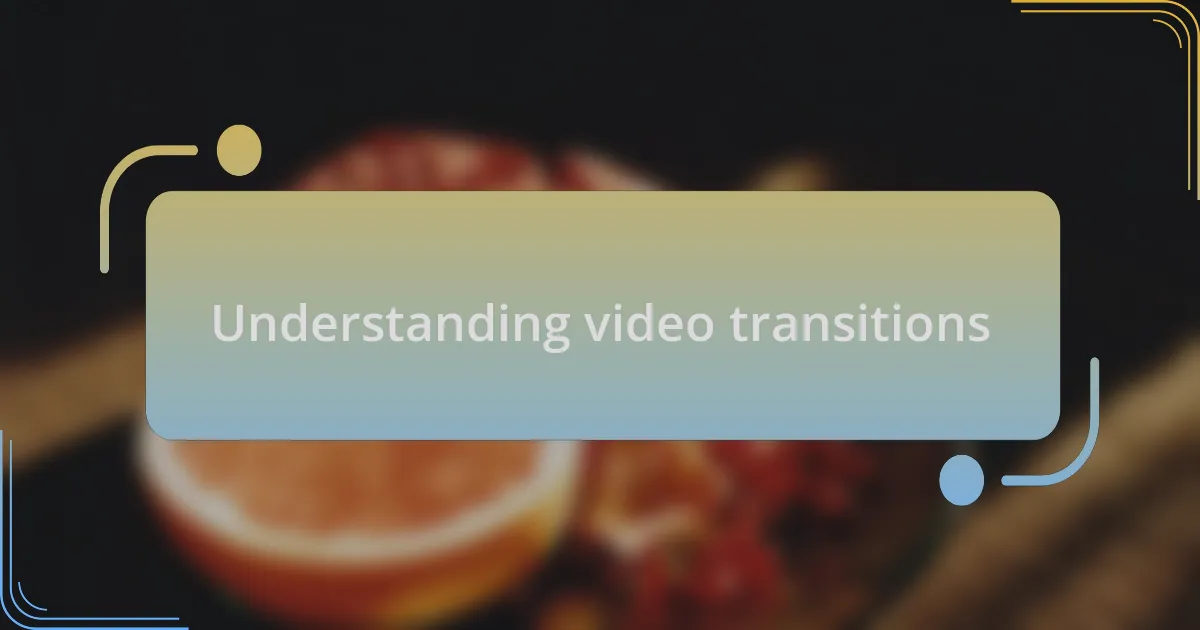
Understanding video transitions
Video transitions are the bridges that connect one shot to another, guiding the audience through the narrative flow. I remember my first experience with transitions, where I simply cut between scenes without much thought. It was a learning moment; I realized how impactful a well-placed transition can be in setting the tone or mood of a scene.
Consider the emotional weight a transition can carry. For instance, using a fade to black can create a moment of reflection, allowing viewers to absorb what’s just happened before diving into the next scene. I often ask myself, “How does this transition enhance the story I’m telling?” In those moments, I’ve found that even the simplest transitions, like a crossfade, can evoke a sense of continuity or change, deeply affecting the audience’s experience.
Moreover, transitions serve as a visual language that conveys meaning beyond the spoken word. I recall experimenting with a quick cut between contrasting scenes—one scene filled with laughter and joy, the next starkly serious. The jarring effect highlighted the emotional shift I wanted to convey. Have you ever noticed that? The right transition can elevate your storytelling, transforming an ordinary sequence into something truly memorable.
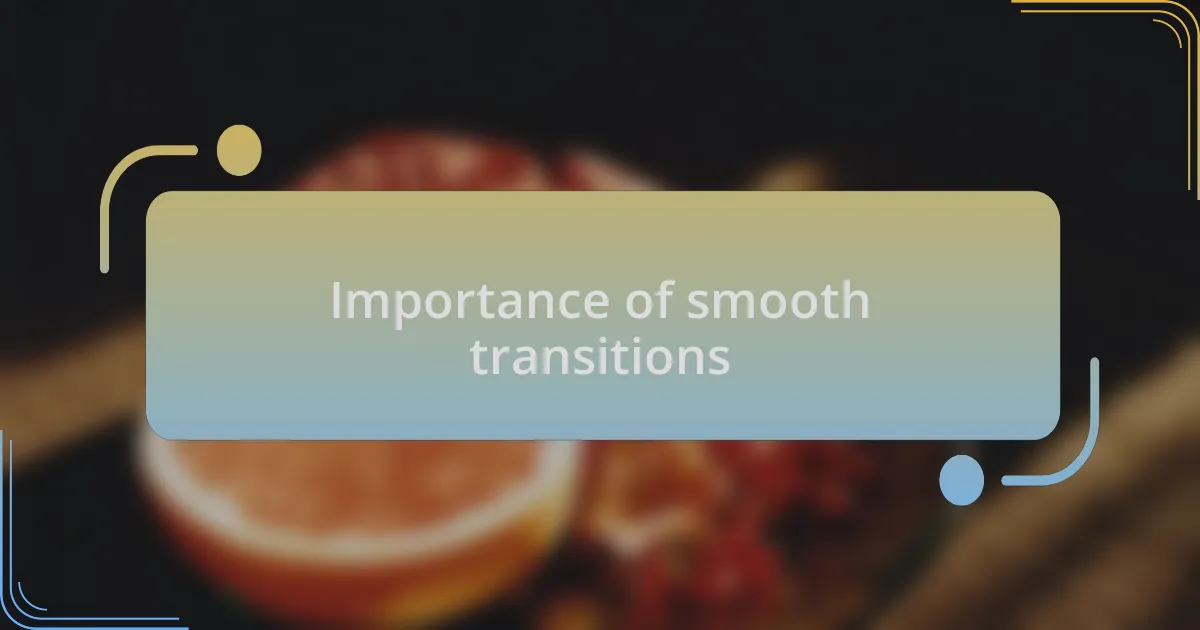
Importance of smooth transitions
Smooth transitions are critical in guiding the audience’s emotional journey through a film. I vividly remember working on a project where a well-timed dissolve not only bridged two scenes but also subtly elevated the tension between characters. It made me ponder, how often do we overlook the power of a simple fade? These moments can define the pacing and emotional resonance of the story, ensuring viewers stay connected rather than becoming disoriented.
I once faced a challenge with abrupt scene changes in a short film I was editing. Feedback indicated that viewers felt jarred and disconnected from the narrative flow. It was a wake-up call for me. I began to experiment with various transition styles, realizing that even a slight shift in timing or type could make a world of difference. Suddenly, the scenes flowed together seamlessly, enhancing the overall impact of the narrative.
Moreover, think about how smooth transitions contribute to coherence in storytelling. I find it fascinating how a subtle wipe can tie together themes or motifs, creating a visual thread that resonates with the audience. Have you ever watched a film where you barely noticed the transitions because they felt so natural? That’s the beauty of mastery in transitions—it’s about creating an invisible connection that allows the story to shine without interruption.
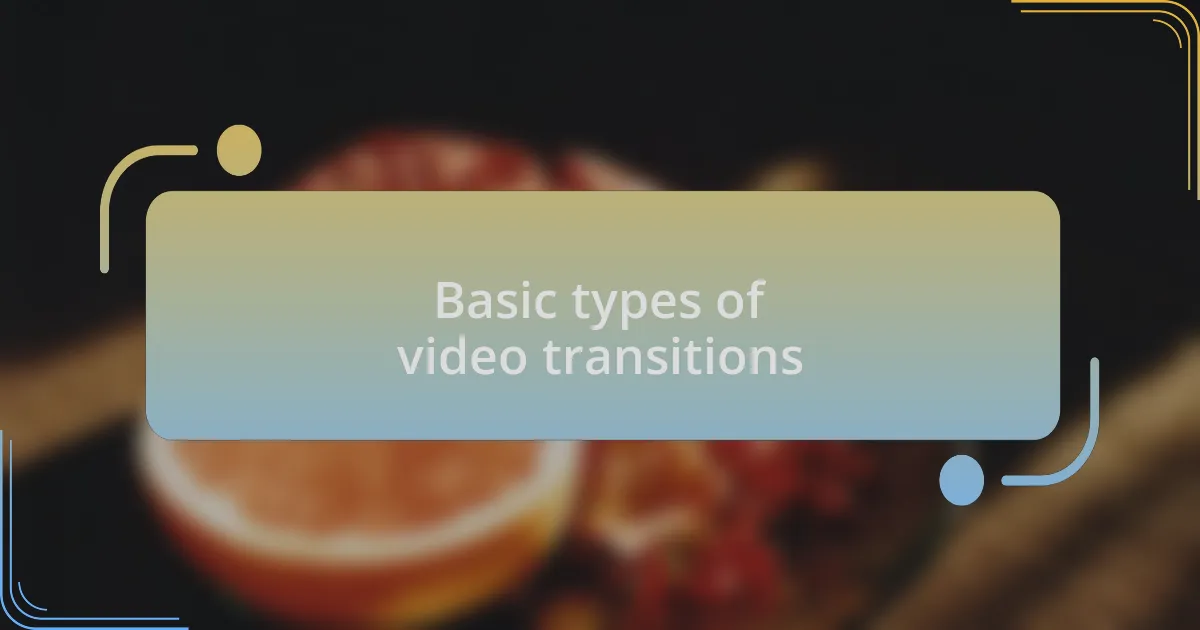
Basic types of video transitions
When it comes to video transitions, there are several basic types that every filmmaker should know. The most common include cuts, fades, dissolves, wipes, and transitions with special effects. I remember my early days of editing when I learned that a simple cut could be as powerful as a grand effect. Think about it: a clean cut can heighten tension and urgency, drawing the viewer right into the action.
Fades, particularly, carry a certain emotional weight. During one project, I used a fade-out to signify the slow end of a character’s journey. It struck me how a simple darkening of the screen could draw out the audience’s emotions, leaving them in a reflective state as the scene gently transitioned. Have you ever noticed how a fade can signal a passage of time or an emotional shift? The power of this subtlety shouldn’t be underestimated.
Dissolves and wipes present another layer of storytelling. I once experimented with a wipe that mimicked the character’s movement, linking two contrasting scenes effectively. It made me realize how such transitions can act as visual cues, enhancing the narrative flow without overtaking the story. Can you recall a moment in film where a transition not only bridged scenes but also enriched the storyline? That’s the magic of mastering these basic transition types; they breathe life into your project, allowing your audience to engage rather than simply observe.
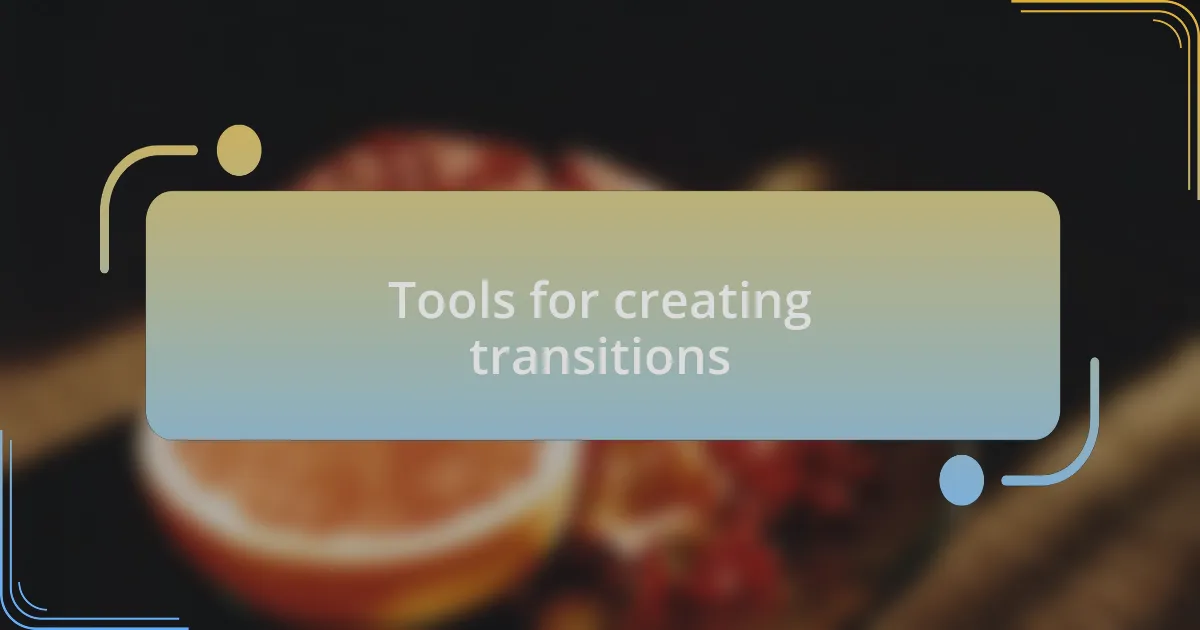
Tools for creating transitions
When it comes to tools for creating transitions, I often turn to software like Adobe Premiere Pro and Final Cut Pro. These platforms offer an array of built-in transitions that can be customized to fit the tone of my project. I remember my first time using Premiere; I was amazed at how quickly I discovered the “cross dissolve” feature, which transformed my raw footage into something more polished and professional.
However, it’s not just about the built-in options. There’s a treasure trove of third-party plugins available that can elevate my transitions even further. One of my favorites is Boris FX, which provides stunning effects that make every project feel unique. I still recall an instance where I integrated a 3D transition that wowed both my clients and my audience—it’s incredible how the right tools can genuinely elevate storytelling.
I sometimes find myself exploring more unconventional options, like audio transitions, which can be just as crucial. Have you ever considered how the sound design in your transition can set the mood? During one project, I seamlessly blended the audio of a running stream into a fade-out, and it added a layer of depth that truly resonated with viewers. It’s a reminder that effective transitions aren’t merely visual; they’re a blend of elements that work together to enhance the overall experience.
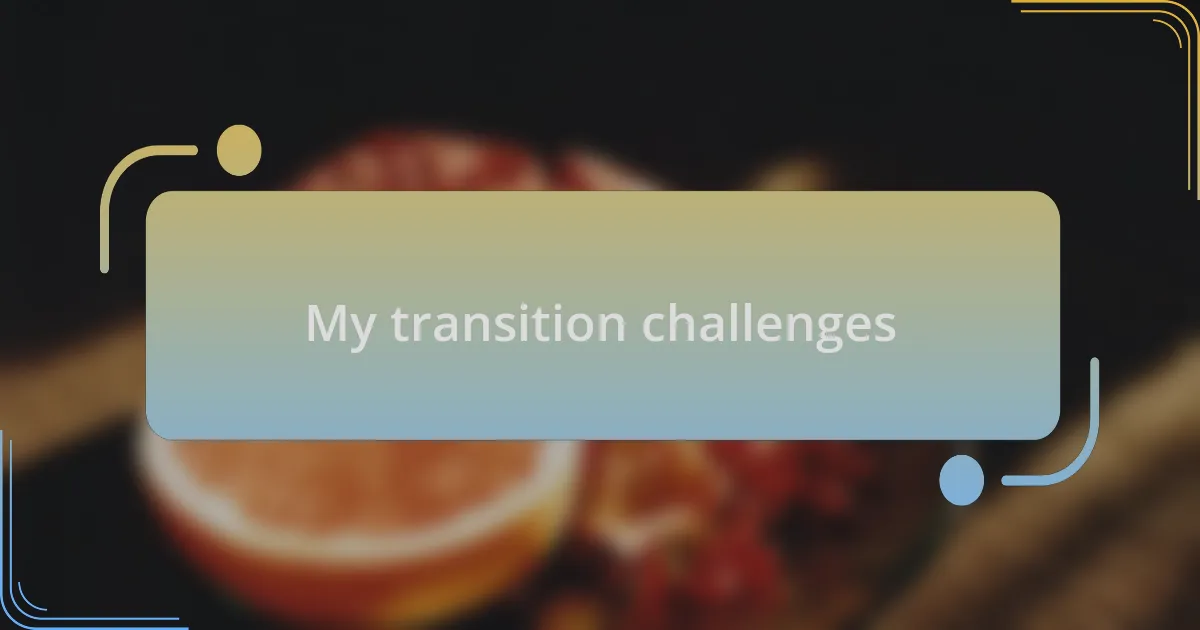
My transition challenges
I’ve faced my fair share of challenges with transitions over the years. Early on, I often struggled to find the right balance between creativity and professionalism. I remember feeling frustrated when a well-crafted transition disrupted the flow of my narrative, making me question whether I was overcomplicating things. You might wonder, how could something so seemingly simple lead to such confusion?
As I dove deeper into video production, I realized that simplicity is often the key. There were times I’d spend hours perfecting intricate transitions, only to realize that a simple cut would have sufficed. This happened during a documentary project where I tried to employ a flashy effect, but my focus on style overshadowed the story. That experience taught me the importance of letting the content dictate the transitions, rather than the other way around.
Another hurdle was the emotional impact of my choices in transitions. I once experimented with a fade-out that aimed to evoke nostalgia, but it didn’t resonate as I expected. Instead of enhancing the moment, it felt forced. Reflecting on this, I learned to connect emotionally with my audience by utilizing transitions that felt organic to the narrative rather than relying on preconceptions of what would look “cool.” Have you ever felt the weight of a decision like that? It’s a reminder that every transition is an opportunity to strengthen the relationship between the viewer and the story being told.
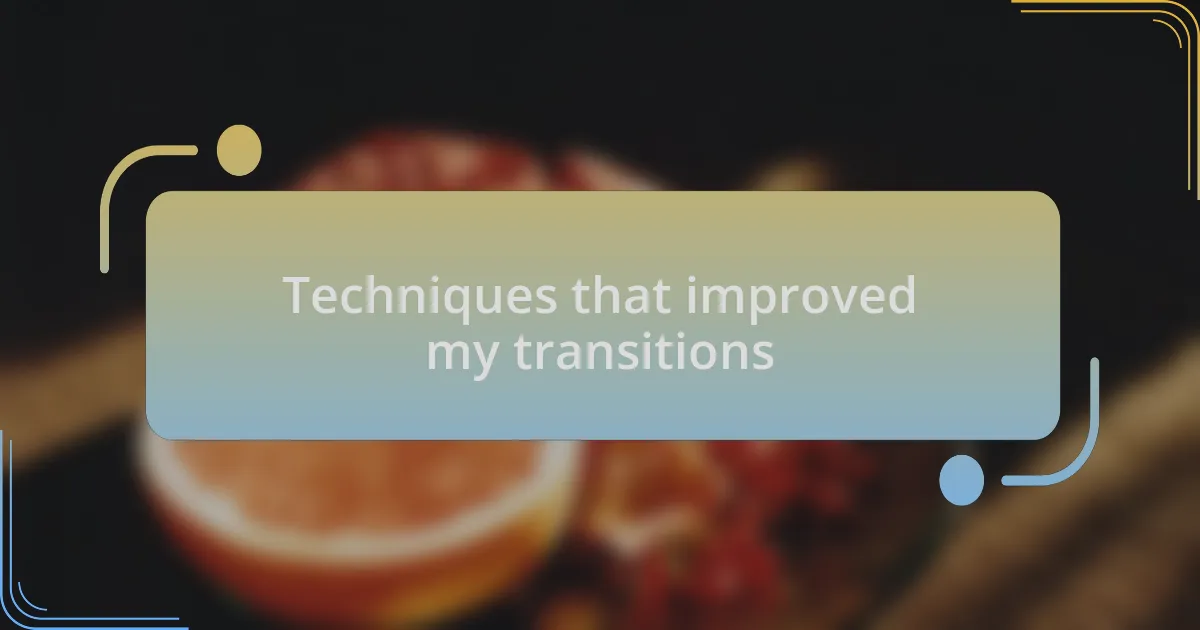
Techniques that improved my transitions
One technique that considerably enhanced my transitions was the utilization of sound design. I found that integrating audio cues can guide viewers more smoothly from one scene to another. For instance, during a short film I worked on, I added a subtle sound effect that coincided with a character’s emotional shift. This not only paved the way for a seamless visual change but also deepened the audience’s connection to the narrative. Have you ever noticed how a mere sound can transform the way you perceive a transition?
Another impactful method was using color grading to create visual continuity. On one project, I realized that varying hues linked two distinct scenes effectively, providing a visual cue while enhancing mood. I experimented with warming up the colors during an uplifting moment, which made the subsequent scene feel like a natural progression. The contrast and synergy between scenes were more pronounced, leading me to understand that color isn’t just a design element; it’s a vital storytelling tool.
Lastly, I embraced the power of pacing. I learned that the timing of transitions can create tension or relief, depending on the desired effect. While editing a suspenseful thriller, I deliberately slowed down the pace before a major reveal, allowing anticipation to build. This shift in speed not only heightened the viewer’s experience but also underscored the gravity of the moment. How often do we overlook the influence of timing in our storytelling? It’s a reminder that transitions are not just technical maneuvers; they are crucial storytelling moments that can elevate the entire narrative.